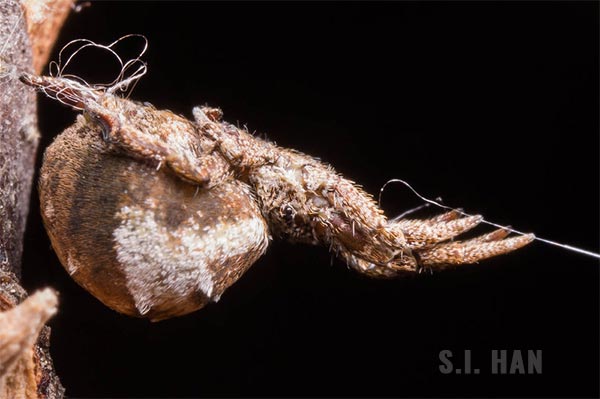Think venomous spiders are scary? Meet a spider that launches itself into the air – at high speeds

(Natural News) The triangle-weaver spider, scientifically known as Hyptiotes cavatus, looks and acts like your friendly, neighborhood house spider at first glance. The most it usually does in a day is build a web and wait for dinner to fall for its trap. However, unlike a normal spider, this particular arachnid does something unusual when a prey finds itself stuck in the spider’s web.
Researchers from The University of Akron in Ohio reveal the mechanisms behind the triangle-weaver spider’s hunting behavior. From its name, this spider weaves a triangle-shaped web, which is unlike the familiar-looking spiral webs. When an unfortunate insect gets trapped in the sticky structure, the triangle-weaver does the impossible and “catapults” itself towards its prey at high speeds. This high-velocity maneuver helps the spider survive because it lacks the venom needed to subdue its prey.
The daring spider on the flying trapeze
Plenty of animals use elastic-energy storage and recoil to perform swift movements. The mantis shrimp, for instance, can send a punch at blinding speeds, giving it one of the fastest predatory strikes in the animal kingdom. However, these mechanisms usually work with internal muscle contractions. In the case of the triangle-weaver spider, it employs a strategy the researchers describe as “external power amplification.”
The spider uses an external device (the web) to store energy, similar to that of a person storing energy in a bow when pulling back an arrow. The spider then releases this stored energy, launching itself like a slingshot. The scientists claim that this is the only known case of a non-human specimen capable of using this strategy.
GLYPHOSATE testing is now being applied to all Health Ranger Store branded products. Our in-house lab uses LC-MS-MS (triple quad mass spec). See the full lab science tour video and announcement here. Shop for ultra-clean, lab-tested superfoods, personal care products and more at the Health Ranger Store, the world's most trusted source for clean foods and lab-verified nutritional solutions.
In a study published in the journal Proceedings of National Academy of Sciences, researchers collected spider specimens near the university and had them build webs in their lab. From there, they enclosed these spiders in terrariums to observe this hunting strategy up close and personal. Researchers used high-speed video cameras and motion tracking software to gather data like velocity and acceleration.
After the triangle-weaver spider finishes building its web, the researchers observed that it weaves a single thread of silk called the “anchor line” to connect the web to a nearby wall. Afterward, the spider moves backward using a “leg-over-leg” motion along this thread to tighten the web and build elastic energy. The spider then coils this web strand between its legs, turning its body into a bridge between the anchor line and the trap line connected to the main web.
This spider can stay in this position for hours, waiting for the perfect moment. When triggered by prey contacting the web or a physical attack on the spider’s body, it releases its grip on the anchor line, which causes both the spider and the web to move forward rapidly. This motion ensnares prey in the spider’s sticky web.
“All of that stored elastic energy causes a recoil and it [the spider and the web] just flings forward, kind of like when you let go of the rubber band,” said study co-researcher Daniel Maksuta. “It really works out too. [If] the prey is massive in comparison to the web and the spider, the web kind of just flings around it. So, that’s how [the prey] gets all tangled up.”
The researchers noted that the spider could repeat this process several times, walking backward to tighten the anchor line again then releasing to entangle their prey further.
“It’s pretty good at catching prey without having to touch it, unlike a lot of spiders,” Maksuta said.
There’s always something new to learn about scientific discoveries, so check out Scientific.news for more.
Sources include:



